The Economics and Statistics Division maintains archives of previous publications for accountability purposes, but makes no updates to keep these documents current with the latest data revisions from Statistics Canada. As a result, information in older documents may not be accurate. Please exercise caution when referring to older documents. For the latest information and historical data, please contact the individual listed to the right.
<--- Return to Archive
For additional information relating to this article, please contact:
February 27, 2024CAPITAL EXPENDITURES, 2022 (ACUTAL), 2023 (PRELIMINARY) AND 2024 (INTENTIONS) Statistics Canada has released preliminary estimates for 2023 and intentions for 2024 (along with revised actuals for 2022) from the annual survey of capital expenditures for non-residential construction and machinery and equipment.
Nova Scotia's capital expenditures were $5.18 billion in 2022, a 22.2% gain over 2021. Nova Scotia's preliminary estimates for capital expenditures in 2023 were $5.79 billion, a further 11.9% increase over 2022. For 2024, capital investment intentions amounted to $6.69 billion, a 15.5% rise over 2023 preliminary values.
Across Canada, capital expenditure growth is decelerating, from 14.0% in 2022 (led by Alberta and New Brunswick) to 8.2% in 2023 (led by Newfoundland and Labrador and Saskatchewan) to 4.5% in 2024 (led by Nova Scotia and Saskatchewan).
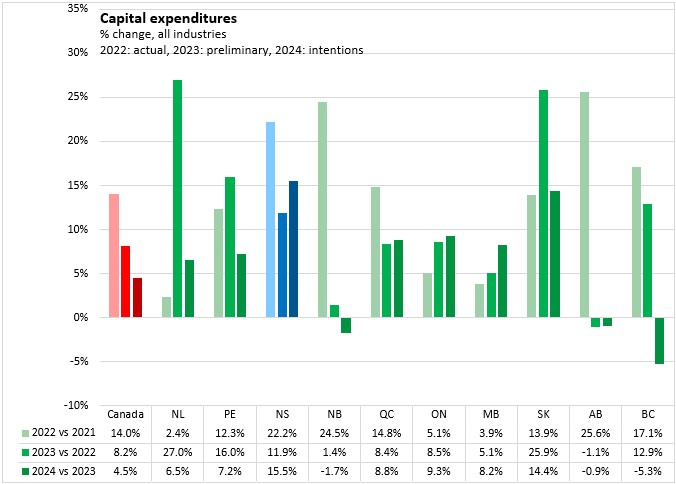
Nova Scotia's private capital expenditures were $2.98 billion in 2022, up 16.6% from 2021. Nova Scotia private capital expenditures increased by 5.4% to $3.14 billion in 2023 with intentions slated to plateau (+0.5%) at $3.16 billion for 2024. Nationally, private capital expenditure growth slowed from 15.8% in 2022 to 4.6% in 2023 and 4.8% intended for 2024. Alberta led private capital expenditure growth in 2022, while Newfoundland and Labrador led private capital expenditure growth for 2023. Saskatchewan leads growth in private capital expenditure intentions for 2024.
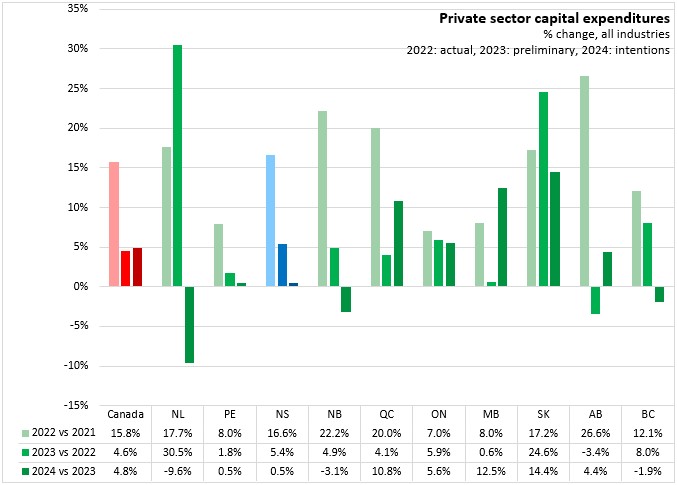
Nova Scotia's public capital expenditures reached $2.20 billion in 2022, up 30.7% from 2021. Public capital spending in Nova Scotia grew by a further 20.6% in 2023, rising to $2.65 billion. For 2024, public capital expenditure intentions are accelerating (+33.4%) to $3.54 billion.
National public capital spending increased by 10.9% in 2022 and by 14.8% in 2023. Public capital expenditure intentions in Canada are projected to slow to growth of 3.9% in 2024. Nova Scotia had the fastest growth in public capital expenditures in 2022. Prince Edward Island and Saskatchewan reported the largest gains in public capital expenditure in 2023. Newfoundland and Labrador reports the largest increase in intended public capital expenditures for 2024.
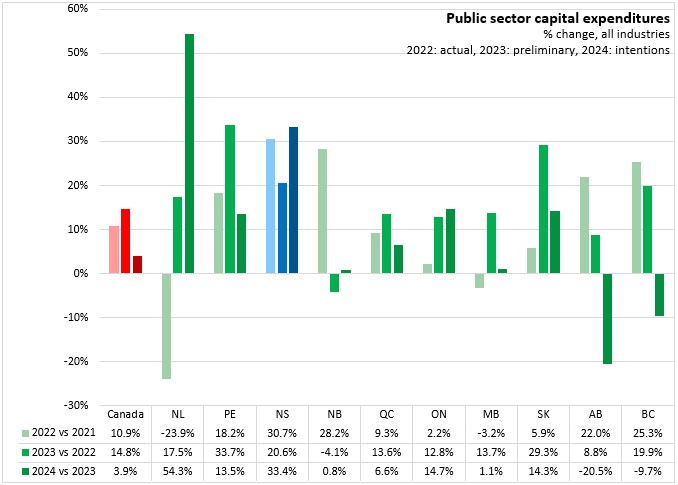
Despite continued growth in capital expenditures, Nova Scotia reported the lowest per capita capital spending of any provinces in either 2022 or 2023. Capital expenditures per capita were notably higher in resource-producing provinces (Alberta, Saskatchewan and Newfoundland and Labrador) as well as in British Columbia.
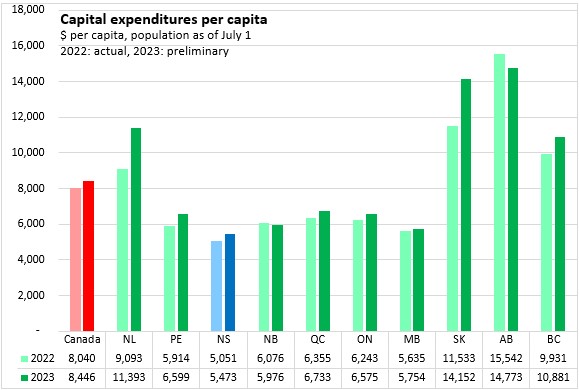
Nova Scotia's private capital expenditures were the lowest per capita values among provinces in each of 2022 and 2023. Private capital investments per capita were highest in Alberta, Saskatchewan and Newfoundland and Labrador.
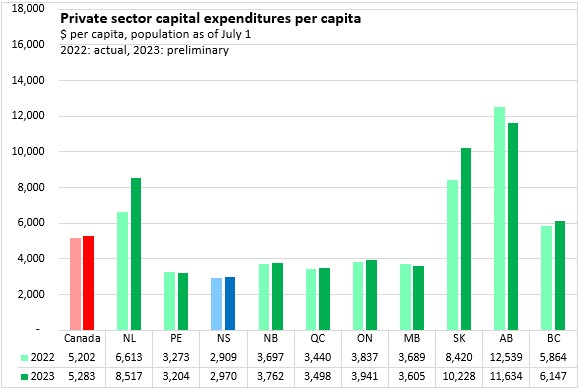
In 2022, Nova Scotia's public capital expenditures were the second lowest per capita value among provinces (ahead of only Manitoba). Despite accelerating growth in 2023, Nova Scotia's per capita public investments were third lowest among provinces (ahead of New Brunswick and Manitoba). British Columbia reported the highest per capita public investments in both 2022 and 2023.
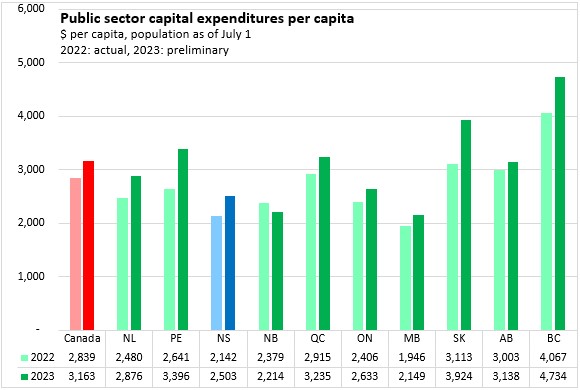
The difference in capital expenditures per capita among provinces is primarily explained by engineering construction (marine, transportation, water/sewage, communications, electric power, oil/gas and mining) as well as machinery and equipment (transportation equipment, industrial/processing equipment, computers, telecommunications equipment, commercial/service industry equipment and scientific instruments).
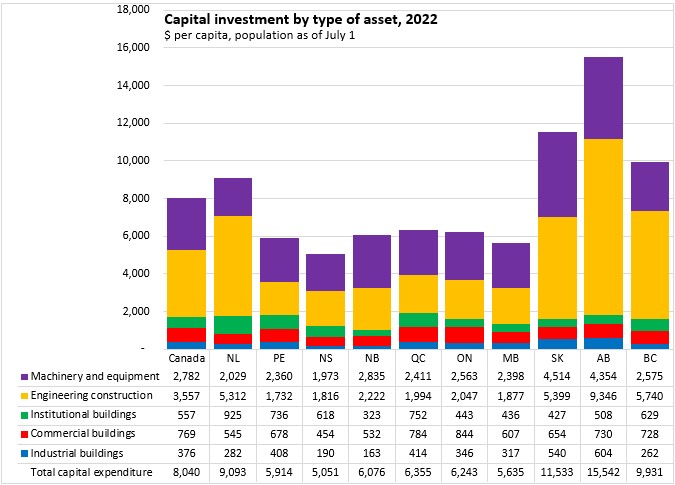
Trends
Nova Scotia's actual capital spending in 2022 was the highest reported in data going back to 2006, reflecting increases in both engineering and machinery spending.
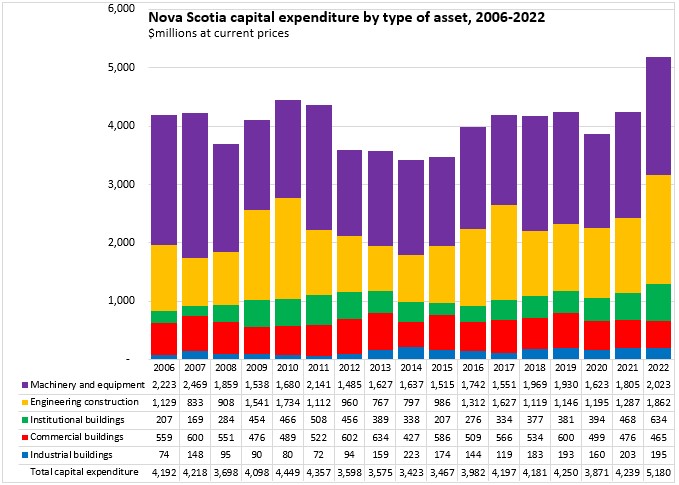
Nova Scotia's private capital expenditures in 2022 reached their highest levels since 2010-2011. Public expenditures were at their highest levels in records dating back to 2006.
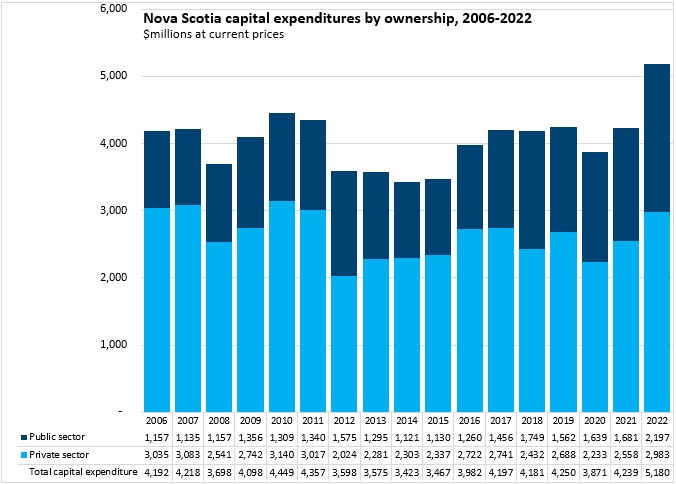
Source: Statistics Canada. Table 34-10-0035-01 Capital and repair expenditures, non-residential tangible assets, by industry and geography (x 1,000,000); Table 34-10-0038-01 Capital and repair expenditures, non-residential tangible assets, by type of ownership and geography (x 1,000,000);Table 34-10-0063-01 Capital expenditures, non-residential tangible assets, by type of asset and geography (x 1,000,000); Table 17-10-0009-01 Population estimates, quarterly
<--- Return to Archive